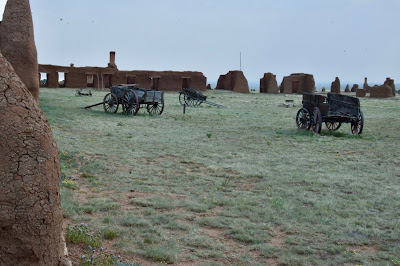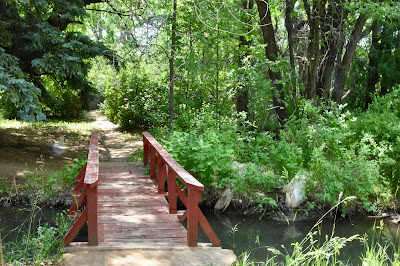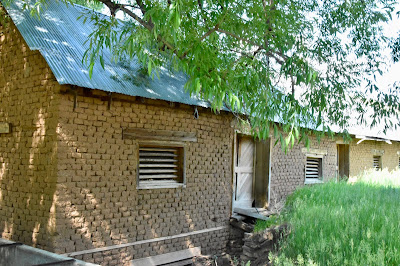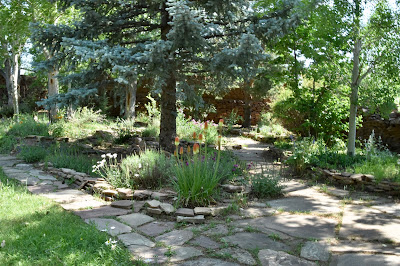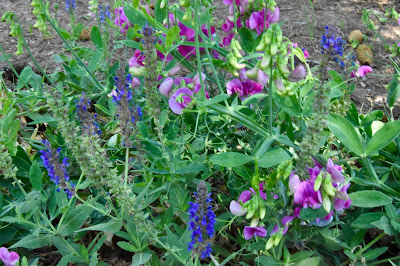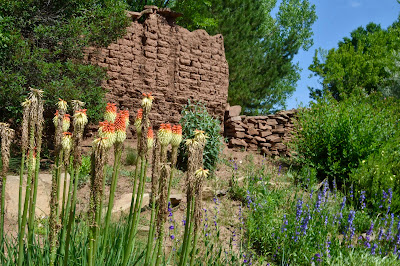Forts & flowers
There’s a whole bunch of territory out there. We typically see bits & pieces of landscape as a blur outside our car windows as we speed toward a destination, but it is vanishingly rare that we actually explore any aspects beyond what are deemed the spectacular points of interest or what can be seen along an established trail.
I can’t say this visit to Las Vegas was any different from that - more like an introductory overview of what constituted our surroundings. The choices were many but we opted to spend our last day in a driving tour off in a northeasterly direction.
One possible sight to see was the Canadian River canyon, and another was a designated federal grasslands. Neither was worth the time it took to get there, truthfully. Can't believe I just wrote that; I usually just stick with the things that are of interest, but the Kiowa National Grassland area, especially, was ridiculous. Some years past, we thoroughly enjoyed exploring Colorado's Pawnee National Grassland, a place of great beauty, and had allowed ourselves to anticipate something similar.
In this case, the designation is applied not to any marked or continuous parcel, but to various unsigned pieces of property dotted here and there somewhere amongst the many private holdings, all of which appear to me to be severely overgrazed.
Designated National Grasslands are essentially "protected and managed" areas that the U.S. Congress in all its wisdom decided to create back in the 1930s to somehow legislate away the possibility of another Dustbowl catastrophe. So, lest I step up more firmly onto my soapbox, I herewith veer away from further mention of "Grasslands".
Can't say the Canadian River canyon was anything to write home about, either. Arizona has multitudes of canyons that knock out your eyeballs, and this was not on a par with them.
Forts now, that's another matter. Although by day's end we had driven more than we had anticipated, the señor pushed on to Fort Union National Monument while I was too fatigued to argue, and was mighty glad that he did.
We could scarcely believe our eyes when we saw the scope of that important military supply post of the mid- to late 1800s. Spread over several miles are adobe, limestone and brick ruins of what was basically a small town, at one time teeming with soldiers and civilian workers who maintained and distributed supplies to military installations all over the Southwest, including Prescott's Fort Whipple. Fort Union was the largest military base between Kansas and California, with thousands of travelers and traders passed through there.
Our walking tour of a portion of the grounds constituted a mile and a half, and was punctuated with signage that explained what we were seeing. There were several places where we saw the wagon wheel ruts of the Santa Fe Trail, the primary route to and from Fort Union.
I fear the valiant efforts to keep the historic walls upright will ultimately give way to the force of gravity as the heavy adobe structures sag and lean under their own weight.
Vast stretches of high grassy plains in that region open to snowy-in-June mountain ranges to the north and west. Instead of the small holdings we encountered at the so-called grasslands area, here are isolated ranch headquarters distantly separated from each other, but all posted, posted, posted. No side roads, no back roads, no opportunity to deviate from the two-lane pavement that wound its way over the prairie. The scenery was reminiscent of Wyoming right down to the abundant pronghorn population.
A former commercial structure that I photographed is only one of scores of adobe ruins throughout that area.
This one held a special surprise: three small fluffy kittens watching the world from their perch in the corner of a boarded-up window.
La Cueva . . .
"When you come to a fork in the road, take it." I often use that witticism supposedly uttered by Yogi Berra when flipping a coin for direction of travel arises. Well, we came to a fork in the road; both directions would get us where we wanted to go, but how perfect that we took the right (literally) one.
We were quickly transported into another age, one of past industriousness and current quiet. It almost felt as if we had stepped through a doorway, beyond which the rest of the world dropped away. Yes, an occasional vehicle drove by on the narrow pavement, but they were not part of our experience.
We had landed at the site of the La Cueva Historic District without ever knowing it existed. There, far out on those vast plains, a family made its home and its mark on history. In the early part of the 1800s, Vicente & Josepha Romero were granted 32,000 acres by the New Mexico Territorial governor.
As Vicente tended his sheep herds, the family are said to have sheltered in caves and fished in nearby streams, thus he dubbed the place La Cueva de los Pescadores - the cave of the fishermen. As a commercial hub on the Santa Fe Trail and with proximity to bustling Fort Union, the settlement also became a social center.
Vicente constructed a large gristmill of adobe and sandstone, built an 8,000 square foot adobe hacienda, established a large mercantile establishment and more, while farming and raising livestock. We wandered through a portion of the settlement: the mill still stands, although signage requested that we not enter it. The impressive mercantile now serves as a country store across the road from an adobe cafe nearly obscured from sight by abundant greenery and high overarching trees.
The farm has become known in current times as a grower of raspberries and offers a u-pick option. Neither the Mill Cafe nor the store were open for business when we were there. I had the notion that they operate primarily during berry season.
In addition to the main buildings, much of which was not visible from our vantage point, there are extensive ruins of sandstone and adobe corrals and other structures.
The gardens, though, were the major attraction for me. It was just in front of the store that we first were attracted to a flower garden. The plantings were partially surrounded by low walls of adobe and sandstone.
As if that peaceful place was not fascinating enough with its continual discoveries of hidden flowering gems, seeming to display a new offering at every turn, we found at the far end a few steps through a break in the wall that invited us up into yet another wonderland of natural beauty.
Even the roadside along the perimeter wall was lush with a roses, sweet peas, red hot pokers, salvia and so much more. What a joy to have found such a paradise so lovingly tended! We left a blessing token for Darren in that quiet place.
Our drive home was primarily via Interstate highways in the interest of expediency; however, the señor did find a back road to allow us more of a mosey before the crazed portion. The route took us along a very narrow very winding pavement that parallelled the Pecos River. As we passed small farm fields anchored by modest adobe dwellings, all mostly obscured by overgrown vegetation with roots into the subsurface moisture of that valley, I felt again as if we had stepped into another era. I feel fairly certain that many, even most of the families dwelling on those smallholdings are descended from the early settlers of Mexican and Spanish heritage who eked out their existence in that peaceful canyon a few centuries past.
A rattler . . .
One thing we have never seen as we hurtled along on a busy highway is a rattlesnake. . . well, really any kind of snake. We do spot them now and again whilst we are in more of a putt-putt mode on back roads, and this was one of those times.
This big boy was stretched out to about 3-1/2 feet in a manner that would likely be injurious to his health from passing cars. Fortunately for him, there were very few on that road. Of course we called a halt to get some photos and to encourage señor rattler to move to a place of less danger. Rattlesnakes are not known to take kindly to manhandling, so fortunately our presence was enough to get him motivated to head for the tall timber, so to speak.
He was not in a particularly defensive mood, but did once think about coiling up at my approach. Never did rattle at all, though.
Look how well the snake is camouflaged when it gets into the vegetation.
A journey's ending, grief persists . . .
Thus ended another journey; we covered the remainder of the miles, arriving home to horribly smoky conditions from wildfires beyond the mountain.
We are grateful for the support we continue to receive from friends and family. Darren's cremains were delivered to our doorstep, bringing a terrible reality to our grief. My emotional need seems to be insatiable: I want to talk about my son all the time, but even the thoughts bring me to tears. Again and again I am assured that the death of a child is something that can be borne. I know that must be true because many have survived the pain, but my heart is not yet convinced.





